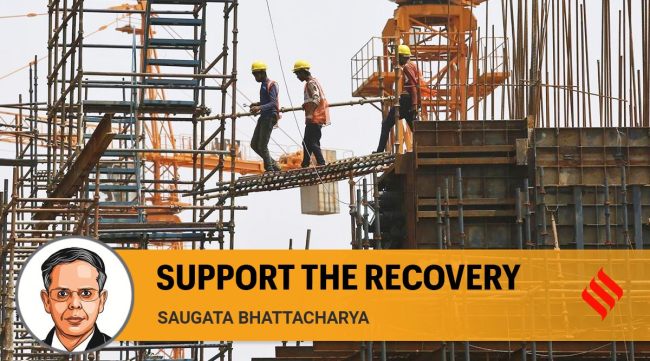Opinion Economic recovery still needs policy support
Saugata Bhattacharya writes: Modest growth signals in third quarter point to need for continuing stimulus.
 The two sectors which contributed most noticeably towards the aggregate growth were manufacturing and construction. (Express Photo: Praveen Khanna/File)
The two sectors which contributed most noticeably towards the aggregate growth were manufacturing and construction. (Express Photo: Praveen Khanna/File) The second advance estimates (2AE) of GDP, released on Monday, projected FY22 real growth at 8.9 per cent, down from 9.2 per cent in the first advance estimates released in January. However, the momentum of recovery and activity is better judged by quarter-wise growth (since this is of more immediate salience).
Real Gross Value Added (GVA) growth in the October-December quarter of FY22 was 4.7 per cent (compared to 2.1 per cent in the corresponding quarter of FY21). GDP growth was a bit better at 5.4 per cent. This growth was only modestly higher than the average growth of 3.7 per cent in the four quarters of FY20, preceding the pandemic lockdown. What does this say about the momentum of economic recovery? Given the high volatility of quarterly growth rates over the past two years, these need to be looked at carefully to separate the base effect from underlying growth.
The two sectors which contributed most noticeably towards the aggregate growth were manufacturing (0.2 per cent) and construction (-2.8 per cent). Even taking into account the base effects of fairly high growth rates in the corresponding quarter of FY21, weakness is visible. The almost flat manufacturing growth is a bit puzzling, given the 27 per cent growth of merchandise exports (by US dollar value) in the quarter, pointing to weakness in domestic demand (although some segments are doing well). Note that IIP (Index of Industrial Production) growth in the quarter was 1.2 per cent and GVA equivalent derived from financial results of manufacturing companies (deflated by the WPI inflation) had contracted by 3 per cent. Equally concerning is the construction segment, where a similar matching of the numbers suggests significant weakness, particularly in the MSME segment. Some of this is supported by weak growth in electricity output (3.7 per cent).
On the other hand, some of the services segments have printed relatively strong growth. The most striking is “Public Admin and Other Services”, which includes education, health, recreation, etc. and is the universe of micro and small local services business; this segment grew almost 17 per cent (and contributed just less than half of the aggregate 4.7 per cent GVA growth).
Even on the demand side of economic activity, the trends are a concern. While private consumption grew by a decent 7 per cent, fixed capital investment rose just 2 per cent in Q3 (on the back of a 0.6 per cent contraction in Q3 of FY21). This was despite a 13 per cent rise in the Centre’s capital expenditure in Q3 (and a smaller states’ capex spend). The obvious inference is that private sector capex had remained weak. Also, given that government consumption expenditure grew only 3.4 per cent, matching this with the “Public Admin” growth above suggests that the other services enterprises had recovered strongly in Q3, with the opening up of economic activity.
In nominal terms, both GVA and GDP growth in Q3 had been 15.6 per cent. This is important, since it is a signal of the distribution of consumption among household income classes. For full FY22, nominal GVA is forecast to be Rs 236 lakh crore, up from Rs 201 lakh crore in pre-pandemic FY20, an increment of Rs 35 lakh crore over two years. This is quite substantial. Apart from private sector studies and surveys on rising inequality, drilling down into company financial results shows that operating profit margins of the business to business (B2B) subset has risen more than those of business to consumer (B2C), thereby suggesting that the ability of end-consumer facing companies to pass on high input costs has been limited. This has implications for the redistributive actions of economic, particularly fiscal, policy.
What of the future? On Q4 FY22 growth, the Axis Bank Composite Leading Index, based on a set of 39 concurrent indicators and nowcasters, suggests that economic activity in February had moved up to almost the December levels (and March activity is usually seasonally strong). Yet, the path of growth and recovery for FY23 has become muddied by a host of economic, commercial, financial and now geo-economic events. The official data release implies that GDP growth in Q4 of FY22 is likely to be slower (4.8 per cent), and GVA at just 4.1 per cent; it is probable that full FY22 growth might be even lower than the currently forecast 8.9 per cent, given a likely hit on exports in March. Moreover, RBI, with its sophisticated forecasting capabilities, thinks that FY23 growth will be 7.8 per cent (lower than the 8.0-8.5 per cent predicted by the Economic Survey and 9.0 per cent by IMF).
Even assuming that the Ukraine crisis gradually settles down, the other ongoing policy actions across the world are likely to unfold over a period of many months, even years. India’s external environment is likely to be less benign than FY22, and financial markets are likely to remain volatile. As the world comes out of the pandemic and the set of extraordinary policy stimulus measures, many G-10 central banks, grappling with high, persistent inflation, are reversing their accommodative monetary policy stance. The US Federal Reserve is expected to aggressively tighten its monetary policy, to hike its policy rates at its March 2022 meeting, and thereafter start extracting the huge infusion of liquidity during the pandemic period.
Global growth is also slowing. IMF, in its January update of the World Economic Outlook, had projected that world GDP growth will decelerate from 5.9 per cent in 2021 to 4.4 per cent in 2022. China’s slowing economy is expected to contribute to this slowdown, but the large developed markets are also decelerating. While logistics bottlenecks for global trade are easing, the nature of demand is also likely to shift from consumer goods towards travel, tourism, recreation, etc. WTO forecasts moderate global trade volumes, falling from 10.8 per cent in 2021 to 4.7 per cent in 2022, mostly led by a drop in emerging markets. Merchandise exports will probably not be as strong a growth engine in FY23, although services exports are likely to accelerate.
Domestic headwinds arising from risks of inflation and fiscal constraints will need deft management of further stimulus to ensure that while the recovery becomes broad-based and more durable, the economy doesn’t overheat. The role of credit and financial resources for both enterprises and retail borrowers has become crucial, particularly for MSMEs. Bank credit offtake had picked up in November and December, but till mid-February remained quite robust. So has NBFC offtake, at least for the larger ones. Some part of this is a diversion from corporate bonds and commercial paper, given rising interest rates, but core credit demand (both working capital and capex loans) seems to have improved.
In short, overall economic activity is recovering at a modest pace, but many sectors and segments still seem to be constrained by demand weakness and will require continued policy support. The role of fiscal and trade policy will be dominant, but monetary policy will continue to have a crucial role in maintaining stable financial markets to reduce at least one component of uncertainty.
This column first appeared in the print edition on March 2, 2022 under the title ‘Support the recovery’. The writer is executive vice-president and chief economist, Axis Bank. Views are personal







